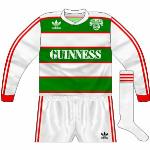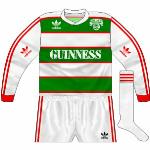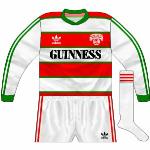Noel O'Mahony's first spell as manager only lasted a season, with former Everton, Wigan Athletic, Port Vale and Republic of Ireland striker Eamonn O'Keefe coming in as player-manager while also looking after the club's commercial operations. O'Keefe immediately set about making changes, bringing former Blackpool defender Billy Haydock in as assistant manager, while his longest-lasting legacy was the signing of goalkeeper Phil Harrington, who would become a club legend, making his final appearance in 2005.
That signing was made at the end of O'Keefe's first season, in May 1988, City having finished in seventh place in the Premier Division for the second consecutive season, 12 points behind champions Dundalk. Again, it was not exactly spectacular stuff in the league, but they were now firmly established as a Premier Division side.
Once more, there were tiny amendments made to the kit, the overall design of green and white hoops with red pinstripes remaining (top left), though the order of the hoops had been reversed. The white wrapover neck returned in place of the v-neck, while the sleeves were now white with three red stripes. Essentially, it was the opposite of the change kit used in 1986-87 (and retained at the start of this campaign), but the adidas logo and club crest were now one hoop higher than they previously had been. Another variation existed (left), featuring additional adidas logos on the sleeves, presumably to allow for greater exposure in pictures.

The Opel League Cup was a source of joy, however, as the club claimed its first major honour, becoming the first Cork team to win the competition and bringing the first national silverware to Leeside since Cork Celtic had won the league 14 years previously. The final, played at Turner's Cross on Wednesday, October 21, 1987, pitted City against Shamrock Rovers, Kieran Myers' 77th-minute glancing header from a Patsy Freyne cross providing the decisive goal. Having already won a first Munster Senior Cup earlier in the season, it was another boost for the still-fledgling club. "It's very early days, but with two trophies after just 10 weeks as manager it augurs well for the future," said O'Keefe afterwards.
Despite being the home side for the decider - which drew a crowd of over 4,000 to the Cross on a weekday afternoon - City lined out in their change kit (top right). The shirt remained unchanged from the previous season, but the home shorts were now used with it. By the time City travelled to Tolka Park to face Rovers for a league game in January, a new away strip was in use (bottom right). Featuring a red shirt with white sleeves, it was very similar to the Arsenal jersey of the time, and it was the first non-hooped shirt to be worn by the club. White shorts and red socks completed the outfit.






